Arvada Fire Protection District celebrates Fire Safety Day






An affidavit filed by Arvada Police Detective Julie Glynn regarding the events of Sept. 11 that led to Officer Dillon Vakoff’s murder was unsealed on Sept. 26, shedding light on the events led to Vakoff’s death and the gunshot injuries of Mercedes Lopez and suspect Sonny Almanza, who is in custody.
The affidavit describes a contentious custody dispute that led to a fight which escalated into exchanges of gunfire.
According to the affidavit, at about 1:45 a.m., Officers D. Garibay and Dillon Vakoff were dispatched to 6753 West 51st Avenue in Arvada on a report of a disturbance over the custody of two children.


Destiny Medlock — Sonny Almanza’s sister — contacted APD for assistance because the mother of the children, Lexis “Lexie” Lopez was on her way to the location to take the children back and Medlock suspected that Lopez was intoxicated.
Officers Vakoff and Garibay arrived on scene and contacted Lopez, who was explaining what was going on to the officers when another vehicle arrived.
The Arvada Fire Protection District hosted its Annual Fire Safety Day on Oct. 1 at the Arvada Fire Training Center, hosting live demonstrations, tours and educational activities to help folks learn about fire mitigation and kick off Fire Prevention Month, which the department is observing throughout October.
Fire Safety Day featured demonstrations of a live burn from the National Fire Sprinkler Association, a helicopter landing from Flight for Life and a seatbelt simulator ride provided by St. Anthony’s Hospital and Colorado State Patrol. Stuffed animal first aid and obstacle


After that vehicle arrived, a fight broke out in the apartment’s parking lot. During the fight, Sonny Almanza retrieved a rifle and came out to the parking lot. Almanza fired a round from the rifle which struck Mercedes Lopez — Lexie Lopez’s sister — in the leg. During the gunfire, Vakoff was fatally shot, according to the arrest affiddavit.
Almanza was also injured and transported to Denver Health Medical Center, while Mercedes Lopez was transported to St. Anthony Hospital.
According to Glynn, Officer Garibay’s body camera footage shows that prior to the physical fight, Lexie Lopez asked officers to ask Medlock about guns in her possession and said “they” pulled an AR-15 on her mother.
After the shooting, Garibay located



Crews begin work on south side of thoroughfare as Phase Two continues
BY RYLEE DUNN RDUNN@COLORADOCOMMUNITYMEDIA.COMThe City of Arvada gave an update on Phase Two of the Ralston Road Bond Project on Sept. 29, detailing a traffic shift that began the week of Sept. 19 and has moved vehicle traffic to the north side of the road while crews work on the south side.

The project is expected to be completed in “late 2023,” according to the Arvada Infrastructure Communications Manager Katie Patterson. Work on Phase Two of the two-phase project began in April 2021. Phase One saw the section of Ralston between Upham and Yukon Streets get widened and receive upgrades to accessibility and pavement conditions.
The north side is newly paved and moving traffic to the south side of the road is an “important milestone,” according to Patterson.
The project aims to expand the travel lanes of the east-west corridor of Ralston Road from nine feet to 11 feet in width. The center turning lane will be expanded to 12 feet wide, and an eight-foot-wide walkway will be added for pedestrians and cyclists. Traffic lights along the roadway will be updated and the


23,000 cars per day, with Arvada’s comprehensive plan estimating that number will rise in the coming years as the city’s population continues to grow.
Phase Two of the project will be funded by money made available from the passage of ballot measure 3F, passed in 2018. The ballot measure allotted $15 million for the Ralston Road renovation.






 BY RYLEE DUNN RDUNN@COLORADOCOMMUNITYMEDIA.COM
BY RYLEE DUNN RDUNN@COLORADOCOMMUNITYMEDIA.COM





Throughout the month of September, Xcel Energy staffers partnered with Arvada City Councilmember Lisa Smith to collect backpacks and school supplies for the Action Center, a nonprofit based in Lakewood. The back-to-school drive collected 4,500 backpacks for Jefferson Coun-
ty Public School students in need.
Smith said she was thankful for Xcel’s philanthropic efforts, which were headed up by Xcel’s West Metro Community Service Manager Daniel Trujillo.
“There are always children and families in need that often go unnoticed in our community,” Smith said. “Something as simple as getting a few members at your work to collect supplies can impact a young child’s life more than you know. Having leaders in the business community that care enough to step up to help the community is the example we hope to see in all our leaders.”
Suspicious death investigation brings Je co Bomb Squad, CSI out to look into situation
BY RYLEE DUNN RDUNN@COLORADOCOMMUNITYMEDIA.COMArvada Police responded to a suicide the morning of Sept.
courses were some of the activities geared towards kids.
The event was open to the pub-
28 on the 5700 block of Lamar Street. The preliminary investigation into the home raised concern of “suspicious activity” and the Jeffco Bomb Squad and
lic and free of charge.
The theme of this year’s Fire Prevention Month is “Fire Won’t Wait, Have an Escape,” encouraging people to have an escape plan they can rely on in case of a fire.
“Our hope is that they come
APD Crime Scene Investigation Unit responded, while Lamar was closed between Ralston and Grandview.
Upon arriving to the scene, officers found a dead person. There were “things in the home that led (APD) to believe the home itself was unsafe,” a spokesperson for the department said. Jeffco
and join us and leave with a number of risk reduction messages, so they take action to live safe lives,” AFPD Battalion Chief Deanna Harrington said. “We want our community to thrive, so it’s a great day to bring together many partners who
Bomb Squad cleared the property and found no hazard.
The department and the Jeffco Coroner’s office did not identify the person, nor provide cause of death. A witness reported seeing bullet holes in a car on the premises. Lamar street reopened to traffic at around noon on Sept. 28. The investigation is ongoing.
share our mission of reducing risk. it’s just a great day for education and spending time with local firefighters.”
AFPD will be visiting schools throughout the month of October to promote fire safety education.
When you go under contract to buy a home, the contract will have a deadline for inspection objection, inspection termination and inspection resolution. Every homebuyer is well advised to hire a home inspector and make use of the opportunity to ensure that the home you end up buying is in good condition.
During the recent sellers’ market it was common for buyers to make their offer more attractive by waiving or limiting their rights to object or terminate based on the condition of the home. Even then, however, the smart buyer hired a professional home inspector so they’d know what they’re getting into.
Home inspectors are not licensed in Colorado, but they are typically certified by one of two professional associations. Your real estate agent can recommend ones that he or she knows are good based on the experience of previous clients.
The home inspector knows enough about every aspect of a home to provide a good overview, including identifying specific defects. In some areas, however, he or she will encourage you to order a secondary inspection by someone with more in-depth expertise in the area of concern. Although a certified inspector can diagnose most electrical or plumbing problems, in some cases he might rec-
ommend a more detailed inspection by a licensed electrician or plumber. That also helps to produce an estimate for inclusion in the inspection objection notice to the seller.
Most inspectors can recognize a structural issue but will typically urge you to have the matter evaluated by a structural engineer. This can cost a few hundred dollars but, like the general inspection itself, could allow you to demand (and hopefully get) the seller to pay for a repair instead of paying for it yourself later on.
Two routine inspections that you should consider and which your general inspector can often perform himself for an additional fee, are the sewer scope and radon test.
A sewer scope consists of running a camera from a cleanout within the house to the main sewer line in the street or alley. Until the late 1900s, most home sewer lines were made of clay pipes that are susceptible to root intrusion and collapse. A sewer scope will cost you between $100 and $150, but is well worth it. If it uncovers a collapse, the repair, if excavation is required, could cost $10,000 or more. You want the seller to pay for that repair, not yourself.
A radon test also costs $100 or so and
consists of installing a computerized device in the lowest habitable area of the house — a basement, if there is one, but only if it’s habitable, whether finished or not. This device samples the air every hour for 48 hours and the resulting measurement is an average of those 48 readings. If the result is in excess of the EPA action level of 4 picocuries per liter of air (4 pCi/L), you should demand that the seller pay for radon mitigation. Mitigation starts at about $1,000 for a single family home, but can be considerably higher if it has a partial basement with an earthen crawl space. Again, the $100 or
so that you spend on the radon test can save you much more if you’re able to get mitigation paid for by the seller.

A final thought: The report produced by your inspector will include every little thing he or she found wrong with the house, because the inspector doesn’t want you to come back later and say he missed something, however insignificant. Typically, your inspector will highlight the serious issues which you should consider for your inspection objection. Even then, it may be wise strategically to omit the minor items that you can fix (or ignore) yourself.
mentioned above, there are three deadlines in the Contract to Buy & Sell:

Inspection Objection
Inspection Termination
Inspection Resolution
Typically the objection and termination deadlines are within a week or 10 days of the date on which you go under contract. Since inspection is the most common reason that a contract falls, both seller and buyer want this date as soon as possible. The buyer can submit an objection or can terminate. If he submits an objection, he
can’t then submit a termination. However, if an Inspection Resolution is not signed by both parties before the resolution deadline (typically 2-3 days later), then the contract terminates automatically.
The Inspection Objection and Inspection Terminations documents are merely notices to the seller, so they are signed only by the buyer. Only the Inspection Resolution document matters, and it is signed by both parties, making it an amendment to the contract, which, by the way, must be provided to the lender.
Golden Real Estate is happy once again to support the Habitat for Humanity pumpkin patches in Lakewood and Arvada. The Lakewood patch is at Garrison Street & Alameda Avenue, on the grounds of Mile Hi Church. The Arvada patch is on the grounds of Trinity Presbyterian Church at 78th Avenue & Wadsworth Blvd.

Both pumpkin patches are operated each year by Jeffco Interfaith Partners, a coalition of a dozen local faith groups. The profits from these two volunteer-manned patches have funded over 20 Habitat for

Humanity homes in the metro area over the past 2+ decades. The pumpkins are grown on a Navajo reservation in the Four Corners area, so the sales also benefit that community, which gets 60% of the proceeds. Habitat gets the other 40%. Yes, the pumpkins sold at our two patches may be more expensive than at your local supermarket, but you have the satisfaction of making a difference with every purchase, and the 40% of your purchase which goes to Habitat is tax deductible. Our thanks go to the two churches for providing great locations for this fundraiser.

Broker/Owner,
JIM
Almanza on the ground with gunshot wounds.
Later on, at Denver Health Medical Center, Almanza was interviewed by two Arvada police detectives after being advised of his Miranda Rights.
Almanza said he lives at 6753 West 51st Ave. and recently separated from Lexie Lopez, with whom he has two children. Lopez and Almanza do not have a court issued custody agreement, but exchange custody mutually. On the evening of Sept. 10, Lopez had the children with her.
Earlier in the morning hours of Sept. 11, Almanza stated that he was in downtown Denver with Medlock and her husband Jacob Marrujo, where Almanza consumed two shots of alcohol. While out, he learned that Lexie Lopez was not with their children and reportedly left them in the care of another family member.
Almanza, Medlock and Marrujo then drove to Lopez’s mother’s house in Thornton, where Almanza reportedly found his children in the care of juveniles related to Lopez. Almanza retrieved the children and brought them to 6753 W. 51st Ave. with Medlock driving.

Almanza reported that he received “threatening messages” from Lopez indicating that she and her family members were on the way to Arvada with the intent of

retrieving the children and beginning an altercation with Almanza.


Before they arrived, Medlock called Jeffcom Dispatch to request officers to assist. Before Medlock was contacted by responding officers, Marrujo received a security notification indicating the door to his residence — also located at 6753 W. 51st Ave., in the unit next to Almanza’s — had been opened.
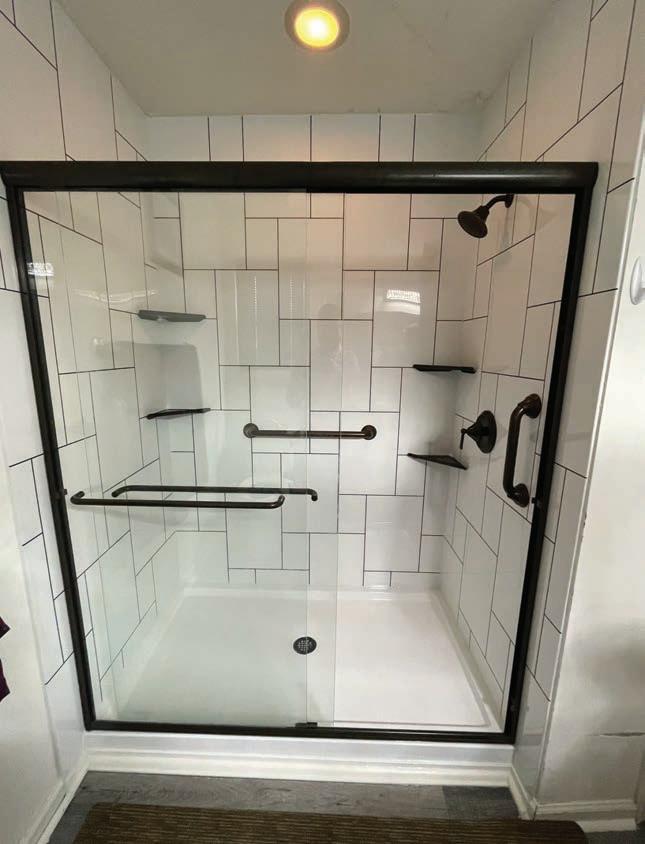

As Medlock approached the apartment, Almanza said he observed several vehicles belonging to Lopez’s family and associates parked on the street near 6753 W. 51st Ave., as well as Lopez’s brother Jerry and sister Mercedes. The Lopez’s approached Medlock’s vehicle as it came to a stop in the street.

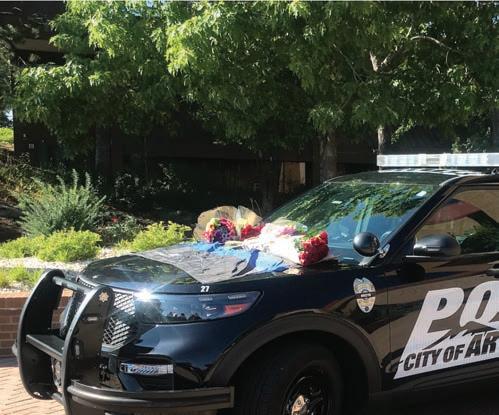
Almanza stated that Marrujo was










attacked by the Lopez family after he exited the vehicle, at which point Almanza allegedly tried to intervene. Almanza told detectives he had reason to believe Lopez’s family were armed.
After being involved in the fight for a few seconds, Almanza allegedly went into his apartment and retrieved an AR-15 assault rifle, which he reportedly kept in his kitchen closet.
Almanza reportedly fired a shot into the air, at which time Mercedes Lopez ran towards him. When she was about 10 feet from Almanza, he fired a single shot at her, at which point she began screaming and fell to the ground.

Almanza continued walking towards the fight, unaware that officers were on the scene. As he approached, Almanza was shot in the hip, pointed the rifle in the direction of the shot, and fired one round.
Officer Dillon Vakoff had been shot and fell to the ground. Realizing he shot an officer; Almanza allegedly ran to his backyard and threw the rifle away.
When he returned to the front of the apartment, Almanza was taken into custody by another officer. Officer Vakoff was fatally shot in the head and leg.
The investigation into the events of Sept. 11 is ongoing. Almanza has been charged with multiple felonies, including three counts of Murder in the First Degree for Vakoff’s death. Almanza is scheduled to appear in court for the second time on Oct. 7.
any ordinances or regulations surrounding the use of them, Woodward said.
In the beginning, the scooters arrived without permission. Now, the electric devices are continuing to spread to more metro-area cities, touted as a way to reduce traffic but also feared by some pedestrians who see them zooming down sidewalks.
“Electric scooters and bikes should only be ridden where bicycles are allowed to ride and should not be ridden on sidewalks unless actively parking, starting or ending a trip,” said Vanessa Lacayo, a spokesperson for Denver’s transportation department.
But officials are still trying to convince scooter users to stay off the sidewalk in Denver, a city where riding scooters irresponsibly is a common sight in the downtown area.
Starting this fall, Denver will test some ideas in the downtown area — where some of the highest ridership in the city takes place — to try to improve safety, Lacayo said.
The city recently finalized a stencil to place on some sidewalks to remind riders to keep the space clear for pedestrians, and officials also have used tech-based strategies to restrict or slow riders down in some busy areas, Lacayo said.
The scooters can mean more than a fun trip for riders and a nuisance
for pedestrians — they’re often involved in injuries.
In crowded Denver, the scooters people often see are the shared ones, which are accessible via cell phone applications and run slower than most car traffic. Lyft scooters, for example, go up to 15 mph, according to the company’s website.
The shared scooters recently spread to more suburban cities. Here’s a look at where they’re allowed, where they aren’t and what the rules are.
Denver’s ordinances, or city laws, say it’s unlawful to ride an electric scooter on a sidewalk at more than 6 mph.
Riding an electric scooter on
PHOTO BY BELEN WARDsidewalks is unlawful except when preparing to park, or when the rider has just mounted and has not yet crossed a street or alley, or where the sidewalk is part of a designated bicycle route, Denver’s city law says.
In Denver, the scooter system has been automatically slowing down and stopping scooters on the 16th Street Mall and slowing them down near Coors Field during Rockies games when many pedestrians are around, Lacayo said.
An online map of scooter use in Denver, referred to by Lacayo, shows the rides are most concentrated in the downtown, central and northwest Denver areas — and some highly trafficked paths stretch close to Lakewood and Wheat Ridge.
Riders in Denver have traveled roughly 11 million miles, according to the city, which estimates the ridership removed millions of driving trips from Denver’s busiest streets and neighborhoods since 2018.
No program in Lakewood Shared scooters first appeared on a large scale in the City of Denver in May 2018 without authorization from the city’s Department of Transportation and Infrastructure to operate, according to Lacayo.
Shortly after, the department ordered scooter operators to suspend their operations while the city developed a permitting process. Denver’s permit program launched in July 2018 to guide how the scooters can be used in the city, Lacayo said.
Nearby, shared scooters are only permitted in some Denver suburbs, but that doesn’t stop them from sometimes ending up where they shouldn’t be.
“Electric scooters and bikes end up in Sheridan mostly by the bus stops or in River Point,” an outdoor mall, Sheridan spokesperson Amy Woodward said.
Sheridan does not have a shared scooter program and does not have
Before Lakewood had enacted any regulations, some shared scooters were deployed in Lakewood in 2018, according to that city.
“We have a pretty good relationship with most companies, and we call to have devices removed when we notice them in Lakewood,” said Stacie Oulton, Lakewood spokesperson.
No licensed scooter companies currently operate in Lakewood, so “personal scooters are mostly what you see in Lakewood,” Oulton said.
Lakewood has required companies to get a license and comply with regulations since 2019, but no company so far has decided to apply for a license, according to Oulton.
“In Lakewood, bicycles are allowed on sidewalks and paths, so scooters are also allowed (in those places),” Oulton said. “They can also ride in bike lanes or streets — just like a bike. In locations we don’t want scooters or bikes, we would install signs with the restriction.”
In the south metro area, Littleton started a partnership with Bird, another shared scooter company — but the “pilot,” or test, program recently ended.
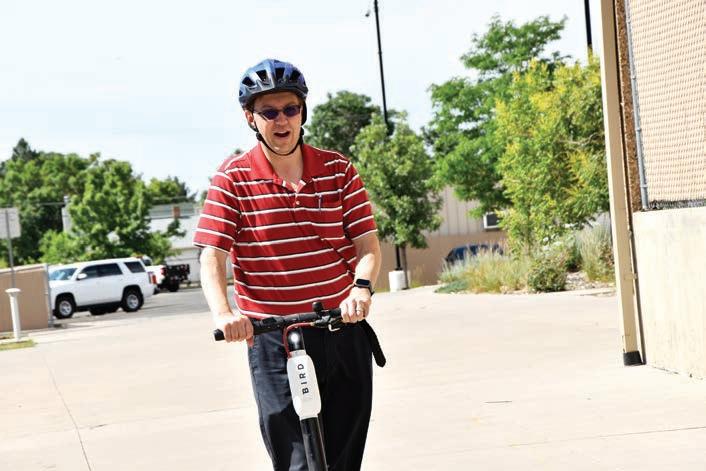
“The one-year Bird Pilot Program began in August 2021 to explore whether dockless e-scooters could provide ‘micromobility’ — an additional mode of travel for Littleton residents to replace short vehicle trips, especially in the downtown (Littleton) neighborhood,” a statement from the city said.
Bird’s local fleet manager, tasked with collecting, charging and servicing the scooters, appears to have stopped doing so in mid-June, leaving many scooters with dead batteries and “therefore impossible to locate remotely,” the statement said.
Littleton city officials have asked for the public’s help tracking down missing scooters. Those who find a scooter should email traffic@littletongov.org with the location, the statement said.

The pilot program was scheduled to end Aug. 18, but Bird decided to end the program in late July, the statement said.

“Arapahoe County will be conducting a county-wide transit and micromobility study in the near future, with Littleton as a partner agency,” the statement added. “Future micromobility programs in Littleton will wait until the study is complete.”









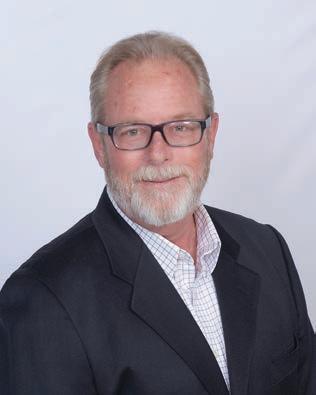



Even though 26-year-old Paige Gray was born with special needs, her mother Karen says Paige and her friends are special in so many other ways.
Karen said Paige and others with intellectual and develop mental disabilities (IDD) “have the biggest hearts and in society today.”
“They’re open minded. They care,” Karen said.
Paige is one of several ambas sadors for Tall Tales Ranch in Centennial, a nonprofit that sup ports people with autism, Down syndrome, and other intellectual and developmental disabilities.
“I feel like it’s important to make new friends because out in the world, you never know who wants to be your friend or who you want to hang out with, and it’s really fun to explore the world out here to find people that you
can hang out with,” Paige said.
The main goal of Tall Tales Ranch is to start a community in Lone Tree where people with IDD can live with those who don’t have disabilities. While the community is being built, the organization is helping the ambassadors with on-the-job training by teaching them how to manage and operate a coffee truck that will eventually travel around the Denver metro area.
“It feels so good. This is my first time making coffee,” Paige added with a laugh. “It feels good to be involved and helping out.”
“We’ve learned so much about our ambassadors — our friends living with special needs — how capable they are and how much they want to be part of the com munity,” explained Susan Mooney, one of the founders of Tall Tales Ranch.
“They want to be productive; They want to have jobs. And it’s very difficult to find employment
The Colorado Sun is a journalist-owned, award-winning news outlet that strives to cover all of Colorado so that our state — our community — can better understand itself. In this way, The Sun contributes to a more
vibrant, informed and whole Colorado.
The Sun, launched in 2018, is committed to fact-based, in-depth and non-partisan journalism. It covers everything from poli tics and culture to the outdoor industry and
for them in a space that’s will ing to make accommodations,” Mooney continued, adding that adults with special needs have unique skills and talents that need to be recognized and uti lized.
Studies show that less than 40% of people with IDD have paid employment and many of those workers are underpaid. However, several companies around Colo rado employ workers with IDD, like DIRT Coffee in Littleton, Pizzability in Englewood, Jack’s/ Steamers in Arvada and Festive Cup Coffee in Highlands Ranch. Mooney and her husband, Pat, started Tall Tales Ranch eight years ago after their son Ross was diagnosed with a genetic condi tion called adrenoleukodystrophy at the age of 14. Ross received a bone marrow transplant to stop the progression and afterwards his parents wanted to find more ways for Ross to engage with the outside world, make friends, work
education.
Now, The Colorado Sun co-owns this and other Colorado Community Media news papers as a partner in the Colorado News Conservancy. The Sun is CCM’s partner for

a job and live as normal of a life as possible. That’s how Tall Tales Ranch was born.
To now see it come to fruition and see it change people’s lives makes me so happy,” Mooney said.
“And I love being able to give them the opportunity … If given the op portunity, they will just shine.”
Sammi Somers is also an am bassador for Tall Tales Ranch. Sommers said the best part of the experience is working with her friends.
“We want to be like the regular community and have jobs, and I’m super happy and can’t wait to get this started,” Sommer said. “Let’s rock Tall Tales Ranch!”
This story is from Rocky Moun tain PBS, a nonprofit public broadcaster providing community stories across Colorado over the air and online. Used by permis sion. For more, and to support Rocky Mountain PBS, visit rmpbs. org.

statewide news.
For Colorado Sun stories, opinions and more, and to support The Sun’s misssion as a member or subscriber, visit coloradosun. com.

Bird also shut down its scooter operations in Aurora effective Aug. 11, according to Aurora’s website.

No shared mobility devices are currently available in Aurora, but licenses remain available for new companies to apply, Aurora’s website adds.



Arvada ties program near RTD line


Northwest of Denver, the City of Arvada approved a pilot program for electric scooters in 2021 and has a contract with Bird for electric scooters to be used within a onemile radius of the RTD G rail line. Arvada’s program with Bird began in January.
“The e-scooters are set to slow down once they get to the boundary line until they fully stop and are no longer operable,” said Katie Patterson, an Arvada spokesperson. “The e-scooters begin chirping and the rider’s phone will receive a notification that they are outside the operating area and redirect them back to where they are usable.”
Before moving forward with the program, the city underwent a research process with the Arvada Transportation Advisory Committee in 2019, followed by community meetings in 2020 and 2021, Patterson said.


Micromobility devices are not allowed on narrow sidewalks and riders should use the devices in the street and on designated bike lanes, similar to personal bicycles, according to Patterson.
The devices are allowed on City of Arvada trails, and users are responsible for following trail rules including giving audible signals when passing slower traffic, Patterson added.
In one notable recent scooter incident, a 10-year-old boy was killed in a traffic accident Sept. 17 on Candelas Parkway. The boy — an Arvada resident — was riding an electric scooter when he was struck by a Toyota Prius. The driver of the Toyota, identified only as a “male driver,” was cooperating with the investigation, according to the Arvada Police Department. The driver stayed on the scene as officers responded.
The scooter the boy was riding was store bought and privately owned, not a ride-sharing vehicle.
To the city’s knowledge, no injuries or deaths related to shared electric scooters have occurred in Arvada since the scooters began circulating in Arvada, Patterson said.
North of Denver, a one-year pilot program for shared scooters began in Thornton on July 1.
“Electric scooters are to be ridden
on streets with a posted speed limit of 35 mph or less, in bike lanes, trails and shared use paths,” said Kent Moorman, a transportation engineer for the City of Thornton.
The maximum speed under Colorado’s Model Traffic Code, incorporated into the Thornton City Code, for this class of vehicle is 20 mph, according to Moorman.
The scooters will bring some amount of tax revenue to Thornton, but numbers are unclear so far.
“Scooter companies are required to have a Thornton general business and sales tax license. We collect sales tax only,” Moorman said. “As this program just started July 1, we do not yet have revenue numbers for the city from electric scooters.”
Under Arvada’s mobility program, companies “must pay a yearly permit renewal fee of $5,000 based on Arvada staff time dedicated to management, oversight, communications, enforcement, and education (regarding) the program,” an Arvada regulations document says.


Denver apparently doesn’t collect revenue from its scooter program.
Lacayo, with the Denver transportation department, said no scooter companies paid Denver any type of license fee or other kind of payment, and that Denver does not receive any sales tax revenue or other tax revenue related to the scooters.
Farther northeast, Brighton city councilmembers decided in April that residents will get access to Bird scooters. A group of Brighton city officials and residents officially welcomed Bird scooters as legal transportation June 30 during a news conference at city hall.
The city has established nine no-rides zones in the city along five streets: Baseline Road, Bridge Street, Bromley Lane, Sable Boulevard and South 50th Avenue. The scooters will not operate on several sections of those streets.
Others without scooters
Commerce City does not have agreements for any electric scooter companies to operate within the city’s boundaries, according to city spokesperson Travis Huntington.
Nearby, Westminster also doesn’t allow for shared electric scooters, according to city spokesperson Andy Le.
The Jefferson County suburb of Wheat Ridge does not have a scooter program, said Amanda Harrison, spokesperson for that city.
“We’d be interested in learning more if a vendor reached out, but that hasn’t happened yet,” Harrison said.
Down south in Arapahoe County, Englewood did not respond for comment by press time about whether it has policies regarding shared electric scooters.
classification or at least get out of it as quickly as possible,” Nichols said.
“Instead, the air division has offered up an ozone cleanup plan that it admits will fail.”
BY MICHAEL BOOTH THE COLORADO SUNThe Environmental Protection Agency can’t let Colorado off the hook for imposing more expensive reformulated gas to fight ozone pollution beginning in 2024, the agency said in a reply to Gov. Jared Polis’ objections and threats to sue.
The gas, which produces fewer ozone-contributing fumes, should cost about 3 cents a gallon more than normal gas formulations, according to an EPA review.
The EPA’s Washington headquarters told Polis that the Clean Air Act dating to the 1990s requires all penalized areas, like the nine counties of the northern Front Range, to switch to reformulated gas when the agency declares them in “severe” nonattainment for lung-damaging ozone.
The change in classification also requires Colorado’s Air Pollution Control Division to lower the threshold for stationary sources that must apply for permits to 25 tons of pollutants from the current 50 tons. Air pollution control officials have said that will add at least 400 new permits to an already backlogged system.

“The Clean Air Act provisions requiring the sale of (reformulated




gas) in areas reclassified as Severe and the timing of those requirements are clear,” national EPA Administrator Michael Regan wrote to Polis. Regan did say the EPA will try to work with Colorado on implementation, and noted the state has “20 months of lead time to prepare.”
The Polis administration did not back down from its objections after hearing from the EPA.
“Gov. Polis has been clear that he will pursue all legal strategies to avoid this outdated and ineffective requirement for reformulated gasoline,” spokesman Conor Cahill said.

“It’s clear that this outdated policy would negatively impact Colorado’s most vulnerable, rewind environmental justice efforts and raise costs
on people when they need their money most.”
The Polis objection letter said the reformulated gas mandate has “the potential to exacerbate longstanding historic environmental injustices in communities near regional refineries. The mandate raises serious environmental justice questions, again particularly given the lack of realized benefits that accompany it.”
Suncor is the only major refinery in Colorado, and likely the one that would supply reformulated gas. While environmental groups and community leaders have asked the Polis administration to phase out Suncor’s Commerce City location altogether, air pollution regulators have recently required more stringent air monitoring at Suncor’s fence line and put new conditions on long-delayed permit renewals.
Polis’ letter said new construction required to supply reformulated gas and higher production levels could hamper air quality progress in those neighborhoods.
While environmental groups do not believe reformulated gas will do much to solve the northern Front Range ozone problems, because current everyday formulations are much cleaner than when the 1990s law was passed, they also dismiss the Polis objections as “reelectionyear theater.”
“There’s no way out of it. It’s going to happen,” said Jeremy Nichols of WildEarth Guardians. Colorado knew the ozone downgrade was coming for years, and Nichols likened the state’s reaction to a high school senior failing all their classes and then complaining they couldn’t graduate.
“If Gov. Polis truly cared about clean air and avoiding RFG, he’d direct the air division to everything in their power to clean up ozone in the region and either avoid a severe
The advocates and allies among metro area elected officials want the state to speed up the transition to lower-emission vehicles, pause air pollution permitting, and put more restrictions on Front Range oil and gas drilling as keys to reducing ozone faster. The state’s proposals so far do not include those extras or others recommended by clean air coalitions.
“Pollution is now bad enough that more federal environmental protections are kicking in, which is exactly why the Clean Air Act exists in the first place,” said Jacob Smith of Colorado Communities for Climate Action, a coalition of 40 local governments. “Trying to avoid the rules will mean it takes longer, costs more and leaves more people sick. The quickest path to not needing federal air quality protections is for Colorado to actually clean up the air we breathe.”
The new State Implementation Plan for ozone attainment that Polis highlighted in his original letter to the EPA acknowledges up front that Colorado can’t meet tighter 2015 standards by a 2024 deadline, noted Katherine Goff, a Northglenn City Council member and vice president of the communities coalition.
“There are enormous emissions sources that Colorado could clean up right now that would make a huge difference, but the proposed plan largely ignores them,” she said.
Suncor said on Sept. 28 it is working on a $36 million project to be ready to produce reformulated gas by the 2024 summer driving season, and that they have state health department approval. The Regional Air Quality Council estimates the new gas will reduce ozone-contributing emissions by 200 tons a year, Suncor said.
What the price differential will be is not clear, Suncor added, since much of it depends on how many other suppliers bring reformulated gas into the Front Range market. Suncor said it currently produces about one third of Colorado’s gasoline, half of the state’s diesel fuel, and 30% of the jet fuel for Denver International Airport.
This story is from The Colorado Sun, a journalist-owned news outlet based in Denver and covering the state. For more, and to support The Colorado Sun, visit coloradosun.com. The Colorado Sun is a partner in the Colorado News Conservancy, owner of Colorado Community Media.
 BY ANDREW FRAIELI AFRAIELI@COLORADOCOMMUNITYMEDIA.COM
BY ANDREW FRAIELI AFRAIELI@COLORADOCOMMUNITYMEDIA.COM
“Now whenever you see ravioli, you can call it Italian varenyky,” joked Chef Bo Porytko, at Ukrainians of Colorado’s cooking class fundraiser.
Hosted on Oct. 2, the fundraiser was filled with 42 students, three cooks and the smells of pletinka, bigos varenyky and borscht.
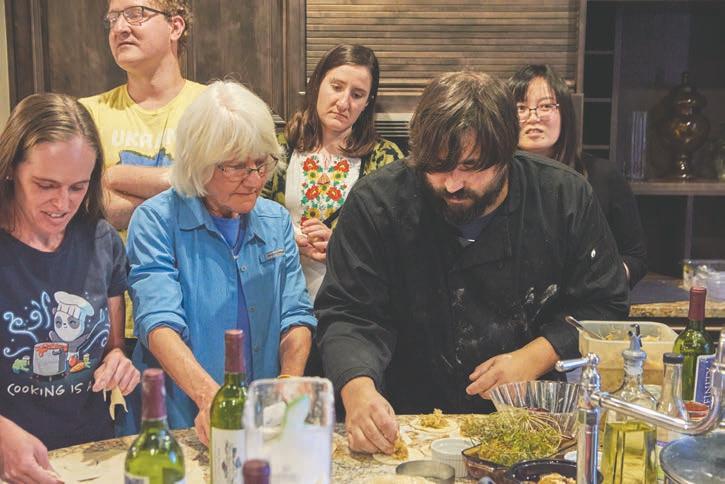
Ukrainians of Colorado is a nonprofit that formed eight years ago in response to the war starting in Ukraine in 2014, when Russia seized Crimea, and for the need of a social club for Ukrainians to “exchange ideas … preserve our heritage, our language … and help Ukraine,” president of the group Marina Dubrova said. The cooking class was one way to do just that.
It had Tetiana Stratilat, a private culinary chef in Kyiv who only arrived in Colorado a few months ago, preparing pletinka — a braided poppy seed bread — with students rolling out the dough and braiding the breads themselves. Before long, Nataliya Dun, who said she’d never taught a cooking class before, had made a potato dish with bacon and crushed onions for everyone to try before starting borscht from scratch.
The most involved for the class
might have been Porytko’s bigos varenyky, or pierogies. After making the dough, people were shown how to roll and cut out the circles to then wrap the varenyky filling in. Porytko, who’s also the head chef of Misfits Snack Bar, had to find another pan because, as he put it, he’d created a varenyky-making monster.
Katya Magee, a Lakewood resident whose grandparents emigrated to the U.S. from Ukraine, said she makes plenty of Ukrainian food at home, but was sure she could learn more.

“It’s definitely a great way to get more exposure to different stories. You’re able to listen to everyone,” said Elvis Dun, who is from Odessa, Ukraine and moved to Colorado in 2014, on the more social aspects.


Also on the menu for Porytko was chicken kiev roulade — a core of butter, garlic, paprika and parsley wrapped with pounded chicken thighs before being breaded and fried. Students were able to pound and wrap their own.
At the same time, Porytko made the point that Ukrainian cuisine is
not one cuisine, but many. Just as food is different from north to south here due to climate, the same goes for Ukraine. He gave the example of south Ukraine, which he compares to Florida, not using many root vegetables due to the summer climate as up north, which he compares to Colorado.
Ukrainian music filled the air alongside the smells of food as people finally sat to eat their creations.
“We drink a lot, we dance a lot,” said Dubrova, as wine and vodka was passed out for the varenyky, borscht — vegetarian and meat — and roulade.
The election season that seems to have gone on forever is about to conclude. I got my Blue Book last week, the county’s Gray Book will be arriving soon, and the county clerk starts mailing ballots Oct. 17. Prepare yourself: It’s going to be a very long one.
Not only are all the statewide offices on the ballot, so are seven countywide positions. Add to that eight state judges, 11 judges in our First Judicial District, 11 statewide ballot measures, and three referred by the Jefferson County commissioners.
Even for a political and policy wonk like me, it’s a bit overwhelming. However, we have three weeks to vote, so take the time to educate yourself and vote all the way to the end, where you will find some of the races and ballot measures that will affect you the most.
Top among them is Jeffco’s Question 1A, which would exclude some fees and state grants — not property taxes — from the TABOR cap, meaning the county could keep the money and not have to refund it to taxpayers.
Treasurer Jerry DiTullio tells me he is about to mail $17.5 million in checks to Jeffco residents because the revenue
LINDA ROCKWELL Columnist

the county received last year was more than it is allowed by TABOR to keep.
Meanwhile the county has been considering possible service cuts. Says Commissioner Lesley Dahlkemper: “Fortunately, the money available to us through the American Rescue Plan Act provides relief for 2023, but budget challenges remain into the future.”


The Jeffco League of Women Voters writes in its letter of support for 1A: “We believe that Article X, Section 20 of the Colorado Constitution, (TABOR), undermines the philosophy of representative government and imposes severe restrictions that prevent an equitable and flexible system of taxation, and reduces the ability of elected officials to provide adequate funding for schools, highways, public safety and necessary social programs, even in times of economic prosperity.”
I urge you to vote Yes on Question 1A.
The other county questions, 1B and

1C, would permit marijuana manufacturing and sales in the unincorporated part of the county, and allow the commissioners to impose a tax on these sales. Pot shops in Evergreen? You decide.
You’re going to have to decide on a lot of other issues, too. Should all public school children receive free lunches? Should a portion of state income taxes be dedicated to increasing the supply of affordable housing? Should grocery stores be able to sell wine? Should the state income tax rate be reduced again?
I strongly urge you to reject this one, Proposition 121. Voters passed Proposition 116 just two years ago, reducing the flat tax rate for individual and corporate incomes from 4.63% to 4.55%. This would reduce it again to 4.40%, cutting state revenue by hundreds of millions of dollars. Over half the benefit would go to those with incomes over $1 million. It would leave less money for K-12 and higher education, for courts and prisons, for public health and human services, and for highway maintenance.
Coloradans are not over-taxed. According to Ballotpedia, Colorado has the lowest per-capita tax collections
of any adjacent state, at about 80% of the national average. One of the arguments for cutting taxes is that “Families and businesses are better off when they can keep more of their own money.” The fact is that families and businesses alone cannot provide a free education to all children, cannot fight crime, cannot deal with the opioid epidemic, cannot run elections and cannot protect our public lands. Taxes are the price we pay for civilization.
It is up to us to make sure that our elected representatives are spending our money wisely. If you don’t have time to communicate with them or attend budget hearings, at least stay informed. Good sources of unbiased information are vote411.org and Ballotpedia.org. Above all, make the time, do your part for democracy, and vote your entire ballot.
Linda Rockwell moved to Evergreen with her family in 1982. She got involved in local land-use issues in 1984 and in the Democratic Party a few years later. She served as chair of the Jeffco Democrats from 1993 to 1997. Good government and principled politics remain her passion.

Coloradans voted in record numbers in 2020 – 3,303,265 ballots were cast, an amazing turnout of 87 percent. People think big national elections are important, and they are, but what many don’t realize is that the decisions most likely to impact their daily lives are made at the local and state level by people elected in midterm elections like the one this year.
What’s more, we’re still reeling from the tumultuous 2020 election and its continuing aftermath, and that may be giving you pause about voting again this year. In fact, are you using one of these excuses?
“Politics is too polarized – I want nothing to do with it!” One reason parties are moving to the extremes is because the small number of voters who hold those extreme positions are more likely to vote than moderates. So,
Consider e-bike impacts on trails
enjoyed Molly Absolon’s article in the September 15th edition of the Arvada Press about electric mountain bikes on trails. It was a well-balanced and well-written article, and the results of the research from the International Mountain Bike Association were interesting. The one outstanding
 REP. LISA CUTTER
REP. LISA CUTTER
the fewer people who vote, the more polarized politics becomes. Higher voter turnout (that means you) in primaries and midterm elections broadens representation and dilutes the influence of extremists.
“My vote isn’t secure.” The Justice Department, the Department of Homeland Security, the FBI and, closer to home, the Colorado State Department and the Colorado County Clerk Association have all confirmed that voting in Colorado is secure and safe from domestic and foreign interference.

“I don’t understand the issues.”
question I have is: does the availability of electric mountain bikes increase the total number of riders on the trails? If so, the increase in riders may have an impact. Have there been any studies that show if ridership increases and if there are any subsequent impacts as a result?
Paul Heller, ArvadaYou don’t have to be an expert, just be informed. It’s easy to get hung up on binaries – is this good or bad? But issues are more nuanced and there are many points of view. Voting is your chance to express yours. You are not likely to find a candidate who mirrors your opinion exactly on every issue, so read up on the things that are most important to you and then find out where the candidates stand.
“I don’t like either candidate.” How do you know? The beauty of local elections is that it is possible to hear candidates in person and perhaps even meet them. Contrary to popular belief, most people run for office out of a desire to serve and once you get to know them, you may like them better than you expect.
And now, the worst excuse of all. “The results are a foregone conclusion
Infrastructure bill a boon for homes in fire danger
I want to share how the Bipartisan Infrastructure Law that passed Congress last year has impacted me and my family personally, in a great way. We have a cabin in northwest Colorado, located in a forested area with beetle kill. Our family works every summer to cut the slash off the
and my vote won’t make a difference.”


Actually, new districts based on the 2020 census were drawn in Colorado by independent commissions, which means that many districts are more competitive than ever before. The Colorado Sun recently reported that there are seven particularly competitive state senate districts, and that is enough to determine which party controls the chamber. In other words, results are anything but a foregone conclusion and your vote can sway the outcome.
Voting is one of the most important ways to exercise your opinion and help shape the community you want to live in. Your voice matters.
Lisa Cutter represents District 25 in the Colorado State House of Representatives and is a candidate for Senate District 20.

deadfall, build brush piles, and burn them in the winter. It’s backbreaking work, but we do this to lessen the risk of a fire. Keeping the woods around our cabin a little cleaner gives the firefighters a chance of stopping a fire before it would reach the cabin.
Because of the massive influx of
Every year in October I write about the choices on the ballot for the fall election. It’s easy to write because explicit recommendations for candidates and ballot initiatives take up a lot of words. While I will make explicit recommendations for all offices up in Jefferson County this year, I think it is important to hear about the quality of candidates up for election. It is important now to realize whether or not someone running for office is a good person.
Maybe six years ago I first met Heidi Ganahl in person at the Automobile Dealers Building. It was a meet the candidates function and we talked only for a half-hour or so. But Heidi impressed me greatly as a woman of both character and substance. Her character was exhibited by the way she rose to the challenge of life’s adversities that are shown at times. Her substance beneath her character enabled her to conquer life’s challenges successfully. I was greatly impressed by her as a
JOE WEBB Columnistperson in that conversation and thought that she deserved to be on the CU Board of Regents. That ambition came true and electing Heidi as our next Governor will put a capable and competent woman in a place where she can accomplish a lot of good for Colorado.
Another good and capable person on the ballot this fall is Jeffco’s own Lang Sias. He is running to be State Treasurer and electing him would put an accomplished man in a key position. Like Heidi Ganahl, I’ve had some conversations with Lang Sias and he is an excellent man of sterling character who would make a spectacular State Treasurer.
Another Jeffco resident, Pam Anderson, is running for Secretary of State. She is a thoroughly competent
professional who would make an excellent Secretary of State. Pam Anderson is also a wonderful and kind person. John Kellner is a very competent prosecutor who would make a wonderful Attorney General. Dan Maloit would make a wonderful addition to the State Board of Education.
Jefferson County has three Congressional districts, CD-2, CD-6 and CD-7. I’ve known Marshall Dawson the Republican nominee in CD-2 for a few years now. He is an excellent man that would make a good Congressman. Steve Monahan in CD-6 and Erik Aadland in CD-7. I’m voting for Molly Lamar for CD-6 representative to the State Board of Education. I’m voting for Joe O’Dea in the contest for the U.S. Senate.
In Jefferson County we have some wonderful local candidates who are seeking election. Chief among them are a wonderful gentleman, State Rep Colin Larson of Littleton, who needs to be reelected in House District 25.
Dan Montoya in House District 28 is a newcomer who deserves to be elected as Jaylen Mosqueria in House District 38. Other candidates that you can vote for are Fred Clifford in House District 23, Bill Patterson in House District 24, Lynn Emrick in House District 27, Vanessa DeMott in House District 29, Russ Carter in House District 30, Mark Baisley in Senate District 4, Tim Walsh in Senate District 20 and Colby Dreschel in Senate District 22.
For local offices, I urge a vote for Don Rosier for County Commissioner, Libby Szabo for County Assessor, Vicki Pyne for County Clerk and Recorder. For the best manner to combat crime I urge a vote for Ed Brady for Jeffco Sheriff. Former Treasurer Faye Griffin should be elected again to her old job. Bob Hennessey should be reelected County Surveyor and Matt Archuleta should be elected County Coroner.
Joe Webb is the former chairman of the Jeffco Republican party.
It’s not a job, it’s a privilege” is Kathi Meyer’s campaign slogan as she runs for Routt County Commissioner this year. Meyer is right that when people run for public office, they are asking voters for the privilege of serving us.
When we elect officials to these offices, we expect them to honor their implied commitment to us to serve their entire terms and not to leave early for what they consider to be better jobs. And yet, that’s what former Jefferson County Commissioner Don Rosier did when he resigned from the Board of County Commissioners with roughly a year left on his term to take a job with the Sterling Ranch Community Authority in Douglas County.
Even though Rosier failed to finish his previous term as county commissioner, he’s now back on our ballots, running for commissioner again. His campaign website touts his previous experience but doesn’t mention the fact that he failed to honor the commitment he made when we gave him the privilege of serving as a county commissioner previously. It provides no explanation of why we should expect that he has any more commitment to Jefferson County taxpayers now than when he resigned from the very same position less than five years ago.
The fact that Rosier walked away from Jefferson County with a year left in his term should give voters pause about his attempt to reclaim the position now. Regardless of who he would be running against, we should be wary of giving him the privilege of serving us again when he didn’t honor us with

funding from the Infrastructure Law, a crew of 19 men with chainsaws cleared away deadfall along the boundary of the property owner’s land and Bureau of Land Management land this summer. The firebreak they created is so much bigger than anything our family could have done, even over many years. We are grateful for this work and thrilled that Congress and President Biden
GREG ROMBERG Columnist

a full term of service.
The fact that his opponent, current Commissioner Lesley Dahlkemper, has served us exemplarily for the last four years and is working on a variety of important issues that she wants to continue to pursue makes it even more obvious that he should not be elected.
As a County Commissioner, Dahlkemper has focused her efforts on effectively managing the county during difficult pandemic times. Her work to continue to emphasize the important role of public safety and open space while making sure county officials manage resources, including COVID relief funds from the Federal government, effectively. She’s championed new efforts related to wildfire readiness, affordable housing and opioids including creating and chairing the Wildfire Risk Reduction Task Force. Based on her record as a County Commissioner, she can make a very strong case that she’s earned the right and privilege to serve us for a second term.
Don Rosier chose to walk away from the privilege of serving us as a county commissioner to take a different job less than five years ago. It’s not reasonable for him to ask us to grant him that honor again in 2022.
Greg Romberg had a long career
passed the Infrastructure Law last year.
When I vote this fall, I will remember that this law passed with almost all the Democrat’s support, but only a handful of Republican votes. It seems to me that Democrats are actively working to solve our nation’s problems while Republicans are motivated only to obstruct, spread fear, and play political games.
I share this story because I believe politics matter in our everyday lives, and that voting is our chance to make things better.
Robin Kupernik, Arvadain state and local government and in government relations. He represented corporate, government and trade as-




sociation clients before federal, state and local governments. He lives in Evergreen with his wife, Laurie.


February 5, 1922 - September 26, 2022
Meade was born to Preston and Loula Abbott and grew up in Glassboro, NJ. During World War II, he served as a paratrooper in the 11th Airborne in the Paci c. Upon his return, he graduated from Bucknell University and became a CPA. He traveled the country with Peat, Marwick, Mitchell eventually settling in Colorado. He served as the nancial director for Je erson and Adams County School Districts before retiring.
In 1957, Meade married Eugenia “Bini” Heise. ey lived most of the next 65 years together on the western shores of Standley Lake on their horse ranch. Meade enjoyed learning and sports, reading constantly and
being a lifelong fan of both the Philadelphia/Oakland Athletics and Denver Broncos. He was also a member of the El Jebel Shriners. Meade is preceded in death by sister Helen and survived by Bini as well as their two children, Scott (Karey) and Kristin Nixon (Rob), grandchildren Christian (Genevieve), Samantha Petersen (Edwin), Sebastian, Alexandria and great-grandchildren Kaiyn, Traivyn, and Lucas. In lieu of owers, donations can be made to El Jebel Shriners at 3443 S Galena St, Suite 250 Denver, CO 80231, or the 11th Airborne Association, 804 S Petite Court, Rogers, AR 72758.
Violet Jean Cribbs
September 15, 1931 - September 3, 2022
Violet (“Vi”) Cribbs (née Major), 90, passed away on 9/3/22. Violet led a full and varied life and is lovingly remembered as a dedicated educator, loving wife, mother, grandmother, and friend to all.


Full Obituary & Services: https://bit.ly/ViCribbs
























































































verybody missed different things when the COVID-19 pandemic forced the world to go virtual. For some it was concerts at their favorite venues, others movies at their local silver screen and for still others it was getting to hear in person from some of the country’s leading historians.
Fortunately for those in the final category, History Colorado has relaunched the in-person version of its Rosenberry Lecture Series. The series kicked off in September with Jorge Zamanillo, founding director of the Smithsonian’s National Museum of the American Latino, and will be bringing fascinating discussions to audiences all season long.
“The series has been a mainstay for a long, long time at History Colorado, where we bring in great speakers from around the state and country, all with an eye toward telling Colorado stories we can all connect with,” explained Jason Hanson, chief creative officer with the organization. “We’re excited to return after two years of virtual talks, which just weren’t the same as the series our patrons have come to know and love.”
The series runs through Wednesday, May 17, 2023, and can be attended inperson at the History Colorado Center, 1200 North Broadway, or virtually. Each lecture will be held on the third Wednesday of the month at 1 p.m.
Some of the discussions attendees can look forward to include:


Oct. 19: Colorado’s Unlikely Gender Crossroads: The Remarkable Story Behind the Book, “Going to
Veteran journalist and magazine editor Martin J. Smith discusses Trinidad’s surprising role as a world center for gender-confirmation surgery, and the doctors and medical pilgrims who have had their lives changed there for 41 years.
Jan. 18: The Life and Times of Colorado Barbecue
James Beard award-winning author and culinary historian Adrian Miller will provide an informative and entertaining look at people and places that shaped Colorado’s barbecue traditions.
March 15: The Once and Future Hope of Dearfield: Colorado’s African American Colony in the Early 20th Century
The African American farm colony of Dearfield was founded east of Greeley in 1910 and black homesteaders were able to realize their dream of owning land and building their own community. The decade-long Dearfield Dream Project is working to tell the story of this unique place. This talk is presented by Bob Brunswig, Ph.D., professor emeritus and university research fellow at the University of Northern Colorado, Richard Edwards, Ph.D., director emeritus of the Center for Great Plains Studies at the University of Nebraska and George H. Junne, Jr., Ph.D., professor and coordinator of
African Studies at the University of Northern Colorado.
“The series is really about helping people realize we’re all connected to a shared past and helping them encounter stories they may not be familiar with or realize is connected to their life in some way,” Hanson said. “You can hear amazing stories about the past and see how we’re all connected by a place called Colorado and the experiences both us and our ancestors have had.”
For information and tickets to the Rosenberry Lecture Series, visit historycolorado.org/rosenberry-lectureseries.
For those looking for the grandeur and sweep of orchestral music with something a little more intimate, you won’t want to miss the Colorado Symphony’s “An Intimate Evening of Famous Quartets,” held at the Parsons Theatre, 1 E. Memorial Parkway in Northglenn, at 7:30 p.m. on Thursday, Oct. 6.
The performance will highlight the music of violins, violas and cellos as they play works from famous composers through the ages. The concert will feature Yumi Hwang-Williams, who has been Concertmaster of the Symphony for more than 20 years.
Get tickets for the concert at https://northglennarts.org/.

If an art exhibit has been going for 49 years, somebody must be doing
something right. The Center for the Arts Evergreen is hosting the 49th Rocky Mountain National Watermedia exhibit, which runs at the gallery, 31880 Rocky Village Drive in Evergreen, through Saturday, Oct. 29.
The annual show is one of the top watermedia exhibitions in the country and goes beyond the traditional transparent watercolor, by including acrylic, egg tempera, gouache and mixed media.
The show is juried by watercolorist Soon Y. Warren, who selected 62 works out of around 500 submissions. For more information, visit http://evergreenarts.org.
I know there are countless reasons to love pop stars like Beyonce and Taylor Swift, but my favorite is Canada’s Carly Rae Jepsen
I’m so excited that Jepsen is releasing a new album — the fantastically titled “The Loneliest Time” — on Oct. 21 and she’ll be at the Mission Ballroom, 4242 Wynkoop St. in Denver, a week before at 8 p.m. on Wednesday, Oct. 12. The initial singles have been quite promising and I can’t wait to hear them along some of her flawless classics. Get tickets at www.ticketmaster. com.
Clarke Reader’s column on culture appears on a weekly basis. He can be reached at Clarke.Reader@hotmail. com.
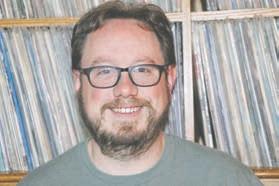
The Lakewood Cultural Center heard Schumann, Beethoven and Liszt
BY ANDREW FRAIELI AFRAIELI@COLORADOCOMMUNITYMEDIA.COMThe Lakewood Cultural Center has started its 2022-2023 season with the sounds of childhood, despair
and trouble through the genius works of Schumann, Beethoven and Liszt, and the graceful hands of pianist Daniel Hsu.
“I think music should be felt, and I think that’s my real goal, my
mission: to make others experience things that they normally wouldn’t,” said Hsu after his Sept. 29 Lakewood concert. A packed theater awaited him as he began with Scenes from Childhood by Robert Schumann, before moving on to Sonata No.31 in A-flat Major by Ludwig van Beethoven.
For this piece, he said Beethoven “writes the sounds of sobbing…,”
and true to his description, Hsu played its simple and direct melodies with tragedy in mind. Tension hung on every note that Hsu played, silence portraying the despair and grief throughout as poignantly as the sharp notes themselves.
The Schumann, which brought out Hsu’s skill of highlighting every
The Peculiar Pretzelmen
@ 8pm
The Jester's Palace, 1527 Champa St, Denver
Shift
@ 8:30pm
Cervantes' Masterpiece Ballroom & Other Side, 2637 Welton St, Denver
Colorado Junction


@ The Bluegrass
Candelas
@ 6pm
The Bluegrass - Can‐delas, 18068 W 92nd Ln #400, Ar‐vada
Jenny Shawhan
@ 6pm
Woodie Fisher Kitchen & Bar, 1999 Chest‐nut Pl Suite 100, Denver
Denver Album Release Show: David Lawrence & the Spoonful @ 7pm




The Black Buzzard, 1624 Market St, Den‐ver
Charlie Hickey
@ 8pm
Globe Hall, 4483 Logan St, Denver
Yoga Relaxation with Live Music
@ 10am / $60
Rooted Heart Yoga and Wellness, 1409 North Ogden Street, Denver. williamoeager @yahoo.com, 570-452-5334

Noche de Verano
Sin Ti @ 9pm
Globe Hall, 4483 Lo‐gan St, Denver
Deorro @ 9pm Ogden

taleen kali

Denver Loves Pets
Masquerade Ball
@ 7pm / $100




Governor's Resi‐dence at the Boettcher Mansion, 400 East 8th Avenue, Denver. lindsay.molloy@ denvergov.org, 720-337-1792
Secret Machines
@ 7pm
Fillmore Auditorium, 1510 Clarkson St, Denver
Keith Hicks
Mool
Molly Nilsson

Westside Boogie

Anxious
Other
Marcus King







that is being done. I want people to be challenged by the stereotypes they may have grown up with or heard about regarding American Indian people and see a different perspective — a much more accurate, resilient and beautiful perspective.”
BY CHANCY J. GATLIN-ANDERSONheard it said that the power of art is like a beating drum; you can feel it in your chest. That’s why people spontaneously cry when seeing certain artworks. It moves you and changes you and you can’t stop it.”
These are the words of Shanna B. Shelby, the chief curator at the McNichols Civic Center Building in Denver. Responsible for bringing artists’ visions to life, Shelby organizes and manipulates the space to help tell an in-depth story.

This season, Shelby has worked diligently with artists to shine light on the beauty and diversity of the human experience, highlighting Native American, Italian and Japanese American artists.
Now through Dec. 18, Denver Arts & Venues will present three new fall exhibitions at the McNichols Civic Center Building, 144 W. Colfax Ave., and a companion exhibit at Buell Theatre, 1350 Curtis St. in Denver. Several exhibition-related events include the fourth event in the Cultural Fashion Runway Series, which celebrates Native American art and fashion.
in themes, media, artists’ backgrounds and approaches. I believe very strongly in the power that original artwork has to educate, inspire and change people,” said Shelby. “More recently, I have been drawn to some international artists that are doing some really incredible work and pairing them with either national or local artists.”
The historic McNichols Civic Center Building opened in 1909 and serves as the Greek Revival architectural background for contemporary artists to showcase their work. The structure also serves as an entertainment space for various events.
shop, meeting, wedding or gala, they


Native American representation is at the forefront of the fall exhibits, highlighting Navajo and Sioux artists and photographical depictions of Native American life. Danielle SeeWalker, member of the Standing Rock Sioux Tribe in North Dakota, is one of the featured artists. She is a Hunkpapa and Oglala Lakota artist, writer and mother based in Denver.
SeeWalker’s writing is displayed alongside photographer Carlotta Cardana as a part of the Red Road Project. According to the project’s website, it formed in 2013 and aims to document, through words and visuals, the inspiring and resilient stories of native America. The stories, not often told, highlight the people and communities that are taking positive actions and demonstrating resilience.
“I want people to know that we are still here. We are thriving, contributing members of society, and doing brilliant work to combat several attempts of genocide and keeping our cultures alive,” SeeWalker said. “Through The Red Road Project, we are able to exemplify this with real life people and highlight the work
SeeWalker and Cardana’s exhibition at the McNichols Civic Center Building is a small sampling of an almost decades-long project. SeeWalker is currently working on a tangential project highlighting “urban Natives,” especially in the Denver area as it relates to the Indian Relocation Act of the 1950s and `60s.
“Most people don’t know that the majority (more than 70%) of Native American people live in urban areas,” said SeeWalker. “I am currently interviewing many folks that came to Denver from the reservation during the relocation period. I’m really excited for Carlotta and I to share that work and uncover a history that has been buried for so long.”
In addition to the art exhibitions, Denver Arts & Venues will be hosting an event as a part of their Cultural Runway Series. The show entitled “WÓHOPA” will take place at 7 p.m. on Oct. 15 at the McNichols Civic Center Building. Prior to the event, there will be a culturally inspired vendor fair for attendees to peruse.


The show features Native designers from tribes with historic ties to Colorado and nearby states. Native fashion designers featured on the runway will include Sky Eagle Collection, Sage Mountain Flower, Red Berry Woman and Choke Cherry Creek. This immersive evening will include a special performance by Supaman and a skateboarding interlude.
“I had been thinking for some time that fine art exhibitions are not always approachable or accessible to general audiences. But fashion is immediately accessible — we all wear clothing and the fashion we choose is a way through which express ourselves,” said Shelby. “Fashion design is an expression of art, just like putting paint on a canvas. So, I thought, why don’t we thematically tie the art on the walls to fashion art, and present a runway show? Thus, the Cultural Runway Series was born.”
For more information on the three exhibits and exhibition-related events, visit mcnicholsbuilding.com.
 BY LINDSEY FORD ROCKY MOUNTAIN PBS
BY LINDSEY FORD ROCKY MOUNTAIN PBS
For more than three decades, the Colorado Association of Black Professional Engineers and Scientists (CABPES) has been working to increase representation in STEM fields.

On Saturday, Sept. 24, the organization joined a long line of booths along Denver’s City Park Esplanade for the annual Energy Day Festival. The yearly festival provides a chance for different companies and organizations to highlight the benefits of a career in STEM, which stands for science, technology, engineering and mathematics.
“We try to break down that stigma that a scientist only has blonde hair and blue eyes,” Earl White said of CABPES. “A scientist can look like you, a scientist can look like me.” White, a Black man, is a board member for CABPES in addition to working as a math tutor, advisor and volunteer with the organization.
The history of CABPES dates back to the late 1970s. Today, there are 120 students registered with the organization, which caters to students in grades 5-12. The nonprofit works to encourage Black students and students from other marginalized backgrounds to pursue an interest in the STEM field.
According to 2019 data collected by the National Science Board (NSB), Black or African American workers make up 12% of the U.S. working
population but represent just 9% of STEM workers. White people, on the other hand, are overrepresented in the STEM field; White people make up 61% of the American workforce but they make up 65% of those working in STEM.



For Earl White, that data show the importance of organizations like CABPES. White said the first step to encouraging Black youth to take an interest in STEM is representation.
“Students of color are actually more prone to go into harder disciplines or … disciplines that they may not have had exposure to if they see someone who looks like them, right?” White said.


“It’s actually vital for us to all come together to the table and figure out how we can expose our children to different areas that they may not even have thought were possible,” White continued.
CABPES offers many programs like SAT/ACT college prep and math tutoring and participates in the national Future City Competition. This competition challenges student members to design an energy-efficient city that can solve sustainability issues.
White said the nonprofit also provides a book club that includes fiction and nonfiction books that center Black characters, yet another example of CABPES’s focus on representation.
One of White’s students is 16-year-old Rahil Shah. Shah said he discovered CABPES at a STEM event at Grandview High School. He has been with the program for five years and said he was hooked ever since White taught him aerospace science.
“Just from a younger age I was watching TV and I saw really cool things, like on PBS … with rockets, engines ... And I got more interested,” he said.
White attended Fisk University, a historically black university in Nashville, Tennessee, where he received his B.A. in Chemistry. He later worked at Lockheed Martin as an environmental chemist for six years. White said that he is currently working toward another major in geology and plans to earn a doctorate in planetary science in the future.
“Never let anything stop you, whatever you would love to do it’s out there. If you need to find


representation, representation is out there no matter how hard it seems,” White said. “Just being able to find mentors and being able to have a safe space to talk with them is very important. Never be afraid to ask for help because asking for help will get to where you want to go.”
This story is from Rocky Mountain PBS, a nonprofit public broadcaster providing community stories across Colorado over the air and online. Used by permission. For more, and to support Rocky Mountain PBS, visit rmpbs.org.
Cat (#256663): Mittens is a 13-year-old, female cat. Petite and precious, this senior tabby is ready to start living the good life in her retirement – in her last home, she enjoyed playing with wand toys and ping-pong balls, going right up to new

FoothillsAnimalShelter.org info@fas4pets.org







 BY KEVIN SIMPSON AND MICHAEL BOOTH THE COLORADO SUN
BY KEVIN SIMPSON AND MICHAEL BOOTH THE COLORADO SUN
For decades, experts feared Colorado’s greenback cutthroat trout to be extinct, a casualty of mining pollution, anglers and more competitive species. So when biologists made the improbable discovery of a naturally reproducing population in a short stretch of Bear Creek west of Colorado Springs 10 years ago, they clung to the hope that the near-miracle could be replicated.
On Sept. 23, Colorado Parks and Wildlife confirmed that the Bear Creek greenbacks now have company. Reintroduction efforts in Herman Gulch, the popular hiking destination just off Interstate 70 near the Loveland ski area, have yielded fish that are reproducing on their own — and sparking renewed optimism that other greenback stocking projects will soon follow suit.
State natural resources officials said the news affirmed their “bedrock mission” to support wildlife across the state and reflected years of collaborative effort among agencies. The stocking in Herman Gulch started in 2016, and now includes its first population of greenback cutthroats — the official state
fish — old enough to reproduce .
“It’s kind of a waiting game for those fish to mature and reproduce,” said Josh Nehring, assistant aquatic section manager for CPW.
“So we’re just super excited and hoping to get a lot more populations out on the landscape.
“In a typical system, when we’re trying to start a population, we

will often stock three-year classes — so stock fry (young fish) for three years in a row,” Nehring added. “And typically in three years they become sexually mature. And so hopefully after three years of stocking or four, we should have adults in the population to where they can start reproducing on their own.”
Colorado Trout Unlimited lauded the announcement as great news for the state’s watersheds, and a reward to the nonprofit’s volunteers who lugged water tanks bearing greenback fry up Herman Gulch multiple years in a row.
“For everybody who helped in some way getting fish into Herman Gulch, it’s a great first step toward that long-term conservation goal,” executive director David Nickum said. Wildlife advocates will be watching to see if reproduction is sustainable for such places in Colorado, he said.
That greenback cutthroat trout have managed to reproduce in the Herman Gulch high country is the latest development in a complicated, decadelong effort to reintroduce the threatened fish to its native streams. Like many species

in the West, the greenback cutthroat used to be native and thriving in multiple streams in Colorado’s South Platte River drainage, which stretches from the foothills and canyons of the Front Range to high mountain waters near the Continental Divide.
A Colorado Parks and Wildlife project for years has kept the public away from stretches of Bear Creek in a canyon west of Colorado Springs, where a reproducing population of the fish was discovered in 2012 following on and off speculation the species might be extinct. CPW teams electroshock small pools in Bear Creek to extract eggs (known as roe) and sperm (known as milt) from the fish before returning them to the
Some of the reproductive material is taken to state and federal hatcheries to develop genetically diverse broodstock. Teams have then taken fingerlings from the hatchery in water-filled backpacks to various promising habitats in the high country — Herman Gulch, Dry Gulch, the west fork of Clear Creek and Williams Gulch. Placing the fish in multiple habitats reduces the likelihood that events ranging from sediment to wildfire to disease pose an existential threat to the species.
But until now, the Bear Creek greenbacks have been closely guarded as the only self-sustaining population. CPW aquatic biologist Cory Noble led a team last spring that strapped on electrofishing backpacks and battled thick underbrush as they worked their way up the creek collecting fish for the project.
Seeing the results of that ongoing effort proved especially gratifying.
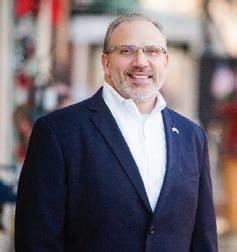

“It’s definitely highly rewarding to see that we’re making a difference now and that we have more than one population that we’re actually making headway in restoring that species out on the landscape,” Noble said. “It is kind of my life’s work, and this makes it seem all worthwhile.”
Although Bear Creek no longer holds the distinction of harboring the only self-sustaining







































































In the first debate between Gov. Jared Polis and his Republican challenger, Heidi Ganahl, the most spirited exchange was about automobiles — and specifically, the ones the candidates drive.

It began as Ganahl attacked Polis’ environmental policies, part of a much broader argument over their visions for Colorado’s future.
“Don’t expect a single mom of three working two jobs to buy (an all-electric) Tesla or rely solely on public transportation,” she said of Polis’ plans to decarbonize the state’s economy in the decades ahead. “It’s too far, too fast.”

Polis shot back: “Well, I thought you drive a Tesla, don’t you?”
Ganahl said her family has three cars, including a “Chevy Express conversion van with 120,000 miles on it.”
Polis responded: “Not everybody can afford a Tesla, like my opponent.”
Ganahl said: “Well, you can.”


In fact, they both can. It was an unusual bit of social showmanship from two candidates who are among the wealthiest people in Colorado. Polis has made hundreds of millions of dollars selling tech businesses, while Ganahl sold her own doggy day care franchise for more than $17 million.
The automotive theater continued as the governor proclaimed that, despite his goal of getting 940,000 electric vehicles on the state’s roads by 2030, he drives “an internal combustion engine. I think that’s all you need to know,” a line which drew laughs.
have previously owned an EV, according to a campaign spokeswoman, and is driven around for official duties in a Chevy Suburban.)
Nathaniel Minor/CPR NewsRepublican candidate for governor Heidi Ganahl, flanked by supporters, released her transportation plan in Denver on Thursday, Sept. 15, 2022.
A minute later, Ganahl revived the topic with an explanation for the Tesla: “I thought, before I ran, ‘I’m gonna get an electric car so I can live it, and feel it, and see what it’s like.’”
Her conclusion: Electric vehicles aren’t feasible for low-income families, and Polis, she added, should “walk the talk” by buying an electric car.
The incumbent’s response? “Lend me yours … I’ll just borrow yours.”
The unusual exchange consumed a few minutes of a debate that stretched
Greater Pueblo Chamber of Commerce at CSU-Pueblo, with sponsorship from Black Hills Energy.
This head-to-head may set the template for the final weeks of the election. Ganahl blamed Polis for high energy costs, bank robberies, rising cocaine and fentanyl use, the auto theft rate and more, and called his COVID-19 response overreaching and underhanded.
She accused Polis of closing schools and churches while “keeping pot shops open.” He contended that Colorado was ahead of many other states in reopening.
“He’s grown the size of government,” Ganahl said. “He’s added taxes, fees, new social programs. Small business owners can’t keep up with all the programs they’re supposed to implement and pay for. There’s only so much money in the bucket.”
Ganahl reiterated her campaign promise to eliminate the income tax, which brings in more than $13 billion a year to the state and supplies more than half of the general fund. She also wants to cut the gas tax in half.
Meanwhile, Polis tried to discredit her tax-slashing plans as unrealistic and dangerous. He pointed out that the Colorado State Patrol and other services are currently funded by those taxes.
“Her gas tax plan (will) cut funding in half for the State Patrol,” he said, while touting his own public safety spending law. “Her income tax plan (will) defund Corrections, let criminals out on the street.”
Ganahl dismissed the criticism, saying she would never cut funds to law enforcement. She has said that she would instead cut spending elsewhere: “We’re going to shrink the size of government by 10 percent a year by doing a hiring freeze and addressing vacancy funds,” she said, adding that she would hire a private auditor to find fraud and waste.
“We have a spending problem here in Colorado, not a revenue problem,” she said.
Cutting more than $13 billion from
the budget would require finding savings equal to the state’s current general fund spending on education, health care, human services and corrections, combined.
Polis said that his administration has saved people money with big new laws on health insurance, full-day kindergarten and limited free preschool. Free early childhood education in particular, he said, saves hundreds of dollars per month for families with young children.
Ganahl said she “fully supports pre-K care,” but said that she’d rather entrust it to private industry, charities and churches. She also would “go all in” on school choice, allowing families to take public funding to the school of their choice.
On criminal justice, Ganahl criticized Polis for reducing the sentence of Rogel Lazaro Aguilera-Mederos, the truck driver at fault in a crash that killed four people on I-70, from 110 years to a decade. (Ganahl said the governor at least should have waited before acting, a criticism echoed by the district attorney in the case.)
Ganahl also pointed out, among other criticisms, that on Polis’ watch, state lawmakers abolished the death penalty.
And in some of her harshest attacks of the night, she accused Polis of signing a law that she said killed the daughter of a woman named Mickey she met on the campaign trail. The policy in question made possession of small amounts of some drugs, including fentanyl, a misdemeanor instead of a felony.
“I hope you will give them an answer and give Mickey an answer,” she said. Ganahl didn’t detail the connection between the death of the person’s daughter and the 2019 drug reform law. Polis responded: “Fentanyl has been, is and will be illegal in the state of Colorado, as long as I am your governor.” He pointed to a law passed this year that reinstated felony possession charges for a gram or more of fentanyl, as well as adding funding for treatment.
The candidates also touched on the issue of water. Polis challenged Ganahl to take a stand against a proposal that had aimed to transport water from the San Luis Valley to Douglas County, where Ganahl lives.
“Even Congresswoman (Lauren) Boebert joined me in opposition to this buy-and-dry plan that would destroy the ag economy of the San Luis Valley,” he said.

Ganahl didn’t take up the topic, but said she wants to build more water storage — also a stated priority for Polis — and promised a firm stance on Colorado River negotiations.
“We’ll neutralize any negotiations on the Colorado River Compact. We only stand to lose in that, and we’ll bal-
Candidates and super PACs shell out hundreds of thousands of dollars to reach voters during Denver Broncos games in election years, hoping to par lay big viewership into a touchdown on Election Day.
And 2022 is no exception.
A Broncos game is typically the most expensive ad time available in Colo rado’s three TV advertising markets — Denver, Colorado Springs and Grand Junction. It’s easy to tell why: nearly 20 million people watched the Broncos lose Sept. 12 to the Seattle Seahawks. And TV ads are often a statewide or congressional candidate’s best shot at influencing voters.
The TV ad air-time rates are most ex pensive in Denver and least expensive in Grand Junction, though they vary among stations in a single market. And super PACs pay far more than candi dates as part of requirements under
ance property rights with community rights,” Ganahl said.
And, of course, when it came to en ergy, they talked about more than just Teslas. Ganahl said Colorado should keep supporting in-state oil drillers, since they’re more efficient than drill ers elsewhere.
“The stakes are so high here, and again, we produce the cleanest energy
federal campaign finance law.
The cost of a Denver Broncos ad varied on the Sept. 25 game on NBC depending on when the ad aired and whether it was purchased by a candi date or super PAC. From top, the price for American Policy Fund in the U.S. Senate contest, 8th Congressional District Republican candidate Barbara Kirkmeyer and Democratic Gov. Jared Polis.
The Colorado Sun examined ad con tracts for the Broncos’ 11-10 win Sept. 25 over the San Francisco 49ers, as well as the Broncos’ Oct. 2 matchup with the Las Vegas Raiders.
The American Policy Fund, a federal super PAC aligned with Republicans, spent $75,000 on an ad attacking Democratic U.S. Sen. Michael Bennet during Sunday’s game on KUSA-TV, also known as 9News. But Bennet and Democratic Gov. Jared Polis each spent only $30,000 for 30-second spots on the same station during the game.
And 8th Congressional District
on the planet right here in Colorado. Let’s get them back to work,” she said. (Colorado’s drilling rig count has shrunk by more than two-thirds while Polis has been in office. That mirrors the trends seen nationwide, includ ing in conservative states like Texas, amid fluctuating oil prices during the pandemic.)
As the debate closed, Polis tried to pin Ganahl as an extremist, narrow ing in on her choice of Danny Moore as her running mate. Moore had questioned the 2020 election results on Facebook, reportedly referring in one
Republican candidate Barbara Kirk meyer’s campaign spent $60,000 on a 30-second spot during the same game. Kirkmeyer’s ad was more costly because it aired in the middle of the game instead of before the start or after the game ended.
The Polis campaign spent $7,000 to air two ads during the Sept. 25 game on KOAA-TV in Colorado Springs, the NBC affiliate in southern Colorado. State-level Democratic super PAC Strong Colorado for All spent $11,250 to air an ad on the station opposing Republican gubernatorial candidate Heidi Ganahl.
In Grand Junction, Polis spent $1,100 for two ads during the Sept. 25 game on NBC affiliate KKCO-TV.
For the Broncos’ Oct. 2 game, Ameri can Policy Fund was to pay KCNC-TV, also known as CBS4, $150,000 to air its anti-Bennet ad. That appears to be the most costly single ad in recent years, according to The Sun’s records.
Polis and Kirkmeyer were each
post to “the Democrat steal.”
“She chose an election denier,” he said.
Ganahl defended Moore, who is a U.S. Navy veteran and an entrepreneur.
“Danny’s made it very clear. He respects Joe Biden and he’s his com mander in chief, as have I, and Danny’s actually an incredible person,” she said.
In her final statement, Ganahl warned of a dark future under Polis. “I will not stand by and watch this beautiful state be destroyed,” she said, accusing Polis of “fighting for his own
scheduled to spend $70,000 for 30 sec onds of air time during that game.
Strong Colorado for All is spending $15,000 for a pre-game ad on KCNC.
In the Colorado Springs market, Polis had two ads booked on KKTV-TV, the CBS affiliate in southern Colorado, for the Oct. 2 game, one at a cost of $4,875 and the other for $3,900. The less expen sive ad runs 15 seconds rather than 30.

Strong Colorado for All is spending $12,500 for a pre-game ad in Colorado Springs.
The Polis campaign was also paying $1,500 to KREX-TV in Grand Junction, the CBS affiliate in western Colorado, to air an ad during the Oct. 2 game.
This story is from The Colorado Sun, a journalist-owned news outlet based in Denver and covering the state. For more, and to support The Colorado Sun, visit coloradosun.com. The Colorado Sun is a partner in the Colorado News Conser vancy, owner of Colorado Community Media.
political career, for his own American Dream to be president and do (to) our country … what he’s done to our state.”
Polis closed out by dubbing Ganahal a “MAGA candidate” citing her own primary election literature, and saying she wants to defund public services, among other charges.
“We can choose to solve problems rather than just talk about them,” he said as he made his pitch for a second term.
At the conclusion of the roughly hour-long debate, Polis crossed the stage and they shook hands.
LAKEWOOD — Columbine running backs MarquaneTaylor and Josh Snyder had no issues finding the end zone Thursday, Sept. 29, at Jeffco Stadium.
Taylor and Snyder combined to score seven touchdowns in the Class 5A Jeffco League opener against Pomona. The Rebels — No. 2 in this week’s CHSAANow.com Class 5A football rankings — took a 50-21victory over the Panthers.
“Both (Taylor and Snyder) ran hard and blocked well for each other,” Columbine coach Andy Lowry said as the Rebels rushed for 471 yards on the ground in the win. “They are making plays right now.”
Taylor had touchdown runs of 38, 1, 56 and 2 yards in the first half. The Rebels held a 29-14 lead at the break. Snyder got into the scoring act with touchdown carries of 2 and 77 yards in the third quarter as Columbine (6-0, 1-0 in 5A Jeffco) extended its lead to 43-21 heading to the final quarter.
“Coach Lowry knows what he is doing,” Snyder said of the Rebels’ rushing attack. “When things are working they are working. Marquane Taylor had a great game with five touchdowns. I’ll block for him. I’ll do anything. It’s awesome.”
Pomona (1-5, 0-1) had its longest scoring drive of the game, 9-play 77-yard drive that was capped off by a 3-yard touchdown run by freshman Luis Santana with 1:56 left in the third quarter to cut Columbine’s lead to 36-21.

However, Taylor had the Rebels’ longest run of the night with a 77-yard touchdown run less than a minute later to push the lead back up to three scores.
“It felt great,” Snyder said of his 77-yard touchdown run late in the third quarter. “All the glory to God. My hoggies (offensive line) and backs were blocking for me. I really didn’t have to do much on that run. I just had to make one guy miss and they did the rest.”
Taylor went over the 200-yard mark on the night with a 71-yard touchdown run after the Rebels’ defense forced a third Pomona turnover on the night with less than
five minutes to play. It was the fifth rushing touchdown for Taylor to give him 15 rushing touchdowns on the season.
“Obviously, it’s a monster with trying to stop Andy’s (Lowry’s offense),” Pomona coach Nathan Johnson said. “We knew that we could hopefully move the ball. A couple of plays just didn’t go our way. I’m proud of our kids.”
Pomona senior quarterback Sawyer Woods — out-of-state transfer
from Utah — had touchdown passes to freshmen Max Lovett and Emmitt Munson in the first half that cut the Rebels’ lead to 22-14 midway through the second quarter.
“That is a tough football team,” Lowry said of Pomona. “Those kids played their butts off tonight. We have some work ahead of us.”
Pomona had the ball at midfield with a chance to completely erase Columbine’s lead in the second quarter, but a big interception by Columbine senior Sam Schraeder set up a late first-half touchdown by the Rebels.
Columbine senior Payton Wainwright had another key interception on Pomona’s first drive of the second half that led to Snyder’s first touchdown run.

“We’ve been talking a lot about growth,” Johnson said after the Panthers’ fifth straight loss after a Week 1 win over Thomas Jefferson. “We are continuing to climb the mountain and get better each practice. I’m proud of what I saw on the field. We are expecting to beat Chatfield next week.”
Pomona hosts Chatfield at 7 p.m. Thursday, Oct. 6, at the North Area Athletic Complex.
Columbine had its biggest challenge of the season facing No. 5 Ralston Valley at 7 p.m. Friday, Oct. 7, back at Jeffco Stadium.
“We just have to keep working and grinding during practice,” Snyder said. “We’ve got to fix a couple of things. We’ve got to be ready for Ralston Valley. We’ll be ready.”
Dennis Pleuss is the sports information director for Jeffco Public Schools. For more Jeffco coverage, go to CHSAANow.com.

LAKEWOOD — It hasn’t been all sunshine-and-rainbows for Chatfield football this season.

The Chargers — last year’s Class 4A state champions — started the season 0-4 in the first year playing in 5A. Chatfield has been able to gain some positive momentum with backto-back wins the last two weeks.
“Last week I said that game was something to build on,” Chatfield coach Kris Rosholt said of the Chargers’ win two weeks ago against Dakota Ridge. “Our boys took it and ran with it.”
Chatfield took a 42-28 win over Arvada West in a game that featured sunshine, rain, lightning and rainbows at Jeffco Stadium on Friday, Sept. 30.
“It is super big for momentum,” Chatfield sophomore running back Brock Narva said of a second straight win for Chatfield. “Every
game is our biggest game from here on out. We all played well tonight.”
A-West (2-4, 0-1 in 5A Jeffco) and Chatfield (2-4, 1-0) were aiming to get off on the right foot when it came to league play. The Wildcats and Chargers both game into Jeffco Stadium with below .500 non-league records, but knew a conference win could turn the tide in a hurry.
Chatfield jumped out to an early 21-0 first-half lead on A-West. Narva did the scoring damage in the first quarter for the Chargers. Narva had touchdown runs of 3 and 2 yards in the first quarter to give Chatfield a 14-0 lead.





“To win in 5A football you have to be able to run the ball,” Rosholt said.
“That is something we knew we needed to get better at. It has been a focal point the last couple of weeks.”
Junior linebacker Avery DeWeese had a big interception of A-West quarterback Ethan Cook that set






the Chargers up on the Wildcats’ 23-yard. Four plays later Narva scored his second touchdown with 3 minutes left in the quarter.
“I have not been great in pass coverage. I’m more of a power guy, but tonight I saw my opportunity,” DeWeese said of his interception. “I think it was a statement of leadership. I want to lead these guys.”
Chatfield junior quarterback Jake Jones threw a great fade to junior Colin Mote with 10:26 left in the second quarter to push the Chargers’ lead to 21-0. The Wildcats were in good position to get on the scoreboard on the next drive, but Cook was intercepted in the end zone by senior Blake Cowgill.
“Every week we want to win the turnover margin. That is huge,” DeWeese said. “If our defense can give our offense more opportunities that the whole point.”
Minutes later the game went into a 30-minute lightning delay.
The delay seemed to give A-West a much-needed spark. Cook hit senior Brady Witherspoon for a 49-yard touchdown with 4:45 left before halftime to cut Chatfield’s lead to 21-7.
A-West had another good chance for a score before halftime, but a hit by junior Cole Roybal on Cook forced a fumble and DeWeese fell on the loose ball for the recovery on the
Chargers’ 18-yard line.
Chatfield answered the bell after halftime with a drive that ate up nearly half of the third quarter. Narva capped off a 60-yard, 9-play scoring drive with his third touchdown of the game with a 2-yard run. The Chargers led 28-7 with 6:41 left in the third quarter.


“Our offensive line really played well tonight. They were getting on their blocks downfield,” Narva said.
After a 35-yard touchdown pass from Cook to senior Andrew Martinez, Chatfield was able to answer again with an 82-yard scoring drive that Jones finished with a short touchdown run on the final play of the fourth quarter.

Cook hooked up with Witherspoon for touchdowns of 9 and 44 yards in the fourth quarter. Chatfield senior Zane Aplanalp scored on a short touchdown run for the Chargers for their final score.

Chatfield heads to NAAC next week. The Chargers face Pomona (1-5, 0-1) on Thursday, Oct. 6, in Arvada.


“We are going to keep rolling and plugging away,” DeWeese said.


A-West will play its homecoming game next Friday night at the North Area Athletic Complex. The Wildcats face winless Lakewood with a 7:30 pm kickoff start.
Dennis Pleuss is the sports information director for Jeffco Public Schools. For more Jeffco coverage, go to CHSAANow.com.








new businesses and state-of-the art tools





support new products that produce superior ROIs for clients. We believe that a creative, learning environment staffed with talented people who want to grow and utilize the newest and best tools will result in a dynamic and successful culture that has a positive impact on our clients business and our community. Our brand is one of the most trusted in our community. We’ve built this reputation by providing award-winning news coverage and by being engaged in our community at all levels. As a true marketer, we want you to bring your experience and expertise to develop the best advertising and audience programs for local advertisers needing to engage with the community to grow their business. We value teamwork. We embrace opinions, perspectives, cultures and backgrounds that energizes the company and fuels our passion to do what’s right for our readers, our advertisers and our employees. If you’ve got the drive and the passion, together we can take your career farther than you’ve ever imagined. We are building a sales team that will be the face of the changing media landscape. We are looking for people who are excited to represent our emerging brands and our trusted, traditional ones too. Join our team, working from our Englewood offices and remote. If you’re as passionate as we are about our mission to grow and engage our community, please apply. This position offers competitive pay and a comprehensive benefit package that includes medical, dental, vision, life, and paid holiday, vacation, sick and personal time. As an added bonus, you’ll office less than 60 minutes from the best Colorado has to offer in outdoor recreation.




Addenbrooke










B.C. Builders LLC requests subcontractor and supplier proposals for 72 unit, wood framed, 3 story building in Ft. Lupton, CO. Section 3, MBE/WBE/DBE businesses strongly encouraged to submit. Please contact Jon Bannister at info@bc-builders.com for information.
Beginner – advanced acoustic and electric
I can teach you what you want to learn!
Songs – music theory etc.
Lessons are taught in my home. 30 years teaching experience. Any day, any time flexible scheduling. Call Leon 303-427-1953


WIDOWED MEN AND WOMEN OF AMERICA.
A social club offering many exciting activities and life long friendships. Social hours for all areas of Metro Denver. Visit Widowedamerica.org for details In your area!

Arvada VFW Post 4331 PARKING LOT SALE! (Weather Permitting)
October 8th 8am - 2pm 5340 Marshall St. Halloween props. Christmas decorations, antiques, tools, sporting goods, collectibles and more!
Scrap Metal, Batteries, Appliances, Wiring, Scrap Plumbing/Heating, Cars/Parts, Clean out Garages/Yards, Rake, Yard work done w/chainsaw, Certified Auto Mechanical / Body Work & paint available
Also can do inside or outside cleaning 303-647-2475 / 720-323-2173

Family in Christ Church
Annual
Vendors & FREE Raffle!

October 21st,
October
N.

Admission: FREE
donation:
Discount air travel. Call Flight Services for best pricing on domestic & international flights inside & from the US. Serving United, Delta, American & Southwest & many more. Free quote! Have travel dates ready! 844-951-2014
Safe Step. North America’s #1 Walk-in tub. Comprehensive lifetime warranty. Top-of-the-line installation and service.
Now featuring our free shower package & $1600 off - limited time!
Financing available. 1-855-4171306
Firewood Split & Delivered $350 a cord Delivery $50. Stacking $50 Call 303-647-2475 or 720-323-2173

VIAGRA and CIALIS USERS! 50 Generic Pills SPECIAL $99.00 100% guaranteed. 24/7 CALL NOW! 888-445-5928 Hablamos Espanol
DENTAL INSURANCE - Physicians Mutual Insurance Company. Covers 350 procedures. Real insurance - not a discount plan. Get your free dental info kit! 1-855-526-1060 www.dental50plus.com/58 #6258.
Attention oxygen therapy users! Inogen One G4 is capable of full 24/7 oxygen delivery. Only 2.8 pounds. Free info kit. Call 877-929-9587
Vivint Smart security Professionally installed. 1 connected system for total peace of mind. Free professional installation! 4 free months of monitoring! Call to customize your system. 1-833-8410737
8inch by 16inch cement blocks
mortar mix 60 pound bags
feet #4... 1/2inch rebar
2x8x20’
2x6x16’ treated
joists
sheets 4’x8’x3/4” plywood
3/8 inch x 2 feet rebar pins 24- TJI joists ( I joist ) engineered to span 20ft
9 foot 2x4s
8foot 2x4s
8foot 2x6s
sheets 4’x8’x1/2” sheathing
roll tyvex house wrap
Shop Cabinets
Like New Appliances and Like New Kitchen Cabinets
smaller deluxe kitchen
303-378-7537





















































FROM PAGE 16
singular tone, savoring every mo ment of silence in between for the feeling of pressure that it deserves, is where Hsu said he feels most comfortable.
“I just tend to like slow more. The Schumann is kind of my home comfort territory, I just feel most comfortable,” he explained. And it showed.
A native of San Francisco Bay


FROM PAGE 20
population of greenback cutthroat trout, Noble said he does not ex pect any changes in the manage ment of the drainage that might loosen restrictions for hikers or bikers.
“We’re still quite a number of years off from having fully re stored greenback cutthroat trout populations throughout the state,” he said. “So I think that Bear Creek does remain critical for the recovery of the species.”

Workers at the Mount Shavano State Fish Hatchery in Salida and the Leadville National Fish Hatch ery also celebrated the Herman Gulch discovery after spending years on the often difficult work of nurturing the broodstock — a smaller population raised in opti


Area, Daniel Hsu, 25, has toured Europe, Asia and North America, with upcoming performances with the Hamilton Philharmonic by Toronto, the Eugene Symphony in Eugene, Oregon, and the Jackson ville Symphony in Florida.
Finishing the program was Franz Liszt’s Sonata in B Minor, a no table departure form the previous two pieces, with Liszt’s style not lending to Hsu’s accentuation of silence, but paired on purpose Hsu said. The piece tells of a “character finding its way through despair and trouble,” Hsu described, continu
mal conditions for breeding and eventual dispersal. Genetic mate rial extracted from cutthroat in Bear Creek makes quite a journey before its fingerlings find their way to waterways that might be conducive to their survival.
Generally, Bear Creek yields few eggs, but the milt from the males gets transported to Salida, where workers relay it to Leadville, where it’s introduced to eggs, which then return to the Salida hatchery to grow. The survival rate is notoriously low — about 10%, said Bryan Johnson, man ager of the Salida hatchery.
“We spend a lot of time counting eggs,” said Johnson, leader of the seven-person crew at the hatchery. “It’s a yearlong process to produce the fish that actually go back into our broodstock. It takes about a (full time equivalent) every year to work on these cutthroats. A lot of times, it hasn’t always been re
ing the more sublime, despairing feelings from Beetoven’s Sonata just before.
These pieces were chosen specifi cally by Hsu as well.
“What I’m really feeling, what I want to play is constantly evolving, constantly changing. Obviously
I love all this music, I don’t play things on stage I don’t love because I feel someone else should do that,” he explained after his performance. “These pieces all mean a lot to me and mean specific things. At one point, these were the only pieces I wanted to play. Now, some time has
warding. Now to see this, it makes everybody happy to see the goal come to fruition after all these years.”


























Thriving trout are an indicator of a healthy watershed, while loss of trout is an early warning sign of a declining stream, Nickum said. Declines of fish and flies for their food on the Colorado River near Granby prompted years of work resulting in the recent groundbreaking for reconnec tion of the river at the Windy Gap dam, which had disrupted natural water flows.
More habitat for the greenback cutthroats broadcast from Bear Creek origins is on the way in Lost Creek Wilderness, once state officials make sure a stream there that is part of the South Platte River drainage is free of whirl ing disease, Nickum said. Other greenback cutthroat projects sup ported by Trout Unlimited are at
passed, and I want to explore other things.”
In the audience for the first concert at the Cultural Center was Emily Gambone and her daughter Aria, 9. She wanted to show her daughter what was possible, as Aria had begun learning to play classical piano in January. They enjoyed the show, with Aria waiting afterwards to tell Hsu that she “admires him.”
The Lakewood Cultural Center’s season continues with acapella quartet Kings Return on Oct. 15, and SALT Contemporary Dance performing on Oct. 29.

various stages at the headwaters of the Cache la Poudre River in northern Colorado, where CPW has developed additional brood stock.
Joe Bushyhead, an endangered species attorney with WildEarth Guardians, called news that the greenback cutthroats have begun to reproduce in Herman Gulch heartening. But he said the work to restore the state fish is not done. “These native fish have a long path to recovery in the wild, and news of a reproducing popu lation marks progress.”
This story is from The Colorado Sun, a journalist-owned news out let based in Denver and covering the state. For more, and to support The Colorado Sun, visit colora dosun.com. The Colorado Sun is a partner in the Colorado News Conservancy, owner of Colorado Community Media.


can address here,” she said.
BY JENNIFER BROWNNate Hailpern was always running toward his mother, bolting from every foster home or residential treatment center he lived in as a kid in the hopes of calling her and going home.
“I ran from everywhere,” said Hailpern, who now has three of his own children and works to help families keep their kids out of the child welfare system.
Tamisha Macklin entered foster care at age 6 and by the time she was a teenager, was living on the streets after running away from her grandma and multiple foster homes, including one where she felt like a maid and had to scrub the floor on her hands and knees.
“I just really struggled with belonging anywhere,” she said. “I always felt like a burden.”
The two spoke Wednesday at the first meeting of a new task force created by the state legislature to figure out how to keep children from running away from foster care placements. The panel — which includes former foster kids, foster parents, social workers, a police officer and county child welfare officials — will meet for two years to come up with solutions.
The task force comes after investigations by the Office of Colorado’s Child Protection Ombudsman into residential treatment centers, including El Pueblo Boys & Girls Ranch, which was shut down by the state in 2017. Last year, a joint Colorado Sun/9News investigation found that kids are running away from the cen-
ters every day and that two boys who ran away from different facilities were struck by cars and killed.
The state child welfare system does not keep track of how many kids and teens in the child welfare system are missing on a daily basis. But in the last year, 35 young people left foster care by running away, according to the Colorado Department of Human Services data. That compares to 208 who emancipated and 745 who were adopted.
“As we sit here today, there are many youth who are on the run and have not been located,” said Stephanie Villafuerte, the state’s child protection ombudsman.
“When youth run, they are in danger. They face dangers on the street, including sex trafficking, violence.
We also know that the number of runaway records far exceeds our law enforcement community’s ability to not only find these children, seek them out, but also to return them. We learned obviously, and sadly, tragically, that when youth run, they not only can get hurt, but they die.”
The task force is named for Timmy Montoya-Kloepfel, who was 12 when he ran away from Tennyson Center for Children in Denver in June 2020 and died after he was hit by a Chevy Tahoe. His mother, Elizabeth Montoya, gave an emotional account of her son’s mental health struggles and the agony of not knowing for 26 hours where he had gone after running away from the residential center.
He was lying in a hospital bed in a coma. He died 12 hours after Montoya reached the hospital.
She asked the panel to look into improving communication among youth residential centers, law enforcement and hospitals. She said she also has concerns about her son’s dosage of medication, which was increased just before he went into the Tennyson Center, and whether the staff caring for him was aware of his history of running away. And Montoya spoke of the gaps in mental health services Timmy experienced in the last few years of his life.
“There are so many things that we
Brandon Miller, executive director of Southern Peaks Regional Treatment Center in Cañon City, told the Timothy Montoya Task Force that staff at youth facilities have to follow strict guidelines that prevent them from physically restraining kids, even to stop them from running away.

“At its basic level, people who are in crisis do one of three things — fight, flee or freeze,” he said. “When these kids run they are in crisis.”
Timmy and Andrew Potter, 15, were killed in separate incidents with similar details — both were struck by cars late at night after running away from different residential treatment centers, two years apart.
Their deaths and the escalating runaway problem at some residential child care facilities sparked calls for investigation and allegations from residential centers that they were suffering from years of inadequate state funding. Some called for review of state regulations that prohibit centers from locking their doors or using physical force to prevent children from running away.
Lawmakers approved $99,500 for the task force’s operations. The twoyear project will include research assistance from the Colorado Evaluation and Action Lab at the University of Denver. The panel must submit reports to the legislature next year and in October 2024.
This story is from The Colorado Sun, a journalist-owned news outlet based in Denver and covering the state. For more, and to support The Colorado Sun, visit coloradosun.com.
The Colorado Sun is a partner in the Colorado News Conservancy, owner of Colorado Community Media.
Ordinance
Legal
First
NOTICE
www.arvada.org/legalnotices, click on Current Le gal Notices, then
of the ordinance you wish
available
on the
City
Contact 720.898.7550 if you have
CB22-069 An Ordinance Amending Various Sections of Chapter 102, Utilities, of the Arvada City Code Pertaining to Water Users Rates and Bimonthly Service Charges.
CB22-070 An Ordinance Amending Section 102206 of Chapter 102, Utilities, of the


CB22-071
CB22-072
As sault and Harassment, of Article II, Miscellaneous Offenses,
Chapter 62, Offenses, of the Arvada City Code.
CB22-073
Arvada

